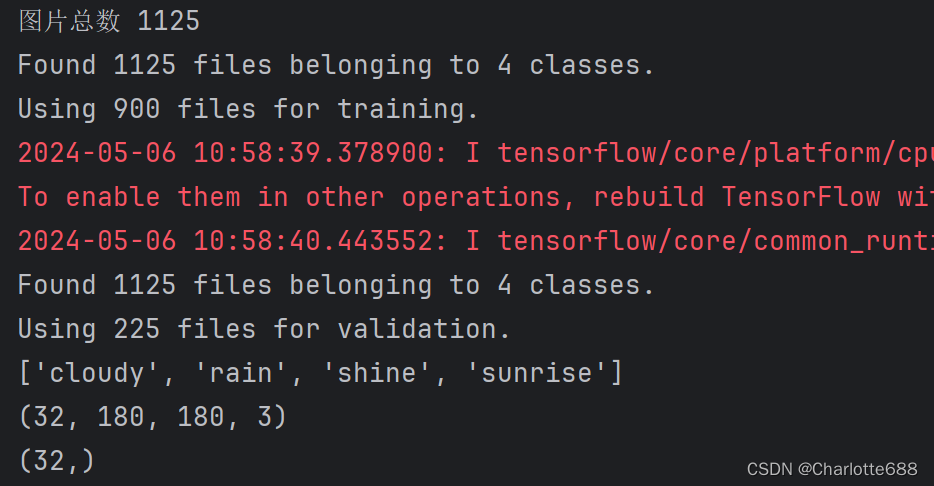DL学习笔记 T3
【TF NOTE】T3 天气识别
前言
- 🍨 本文为🔗365天深度学习训练营 中的学习记录博客
- 🍖 原作者:K同学啊
本次将采用CNN实现多云、下雨、晴、日出四种天气状态的识别。
一、设置GPU
#设置GPU
import tensorflow as tf
gpus = tf.config.list_physical_devices("GPU")
if gpus:
gpu0 = gpus[0]
tf.config.experimental.set_memory_growth(gpu0, True)
tf.config.set_visible_devices([gpu0], "GPU")
二、正式开始
1.加载数据
加载下载到本地的天气图片数据并可视化
#一顿import
import os, PIL, pathlib
import matplotlib.pyplot as plt
import numpy
from tensorflow import keras
from tensorflow.keras import layers, models
#找到数据存放的地址
data_dir = "D:/BaiduNetdiskDownload/D5/weather_photos/"
data_dir = pathlib.Path(data_dir)
#可视化数据,查看日落文件夹里的第一个图片
image_count = len(list(data_dir.glob('*/*.jpg')))
print("图片总数",image_count)
roses = list(data_dir.glob('sunrise/*.jpg'))
PIL.Image.open(str(roses[0]))
#将下载数据加载到tf.data.Dataset
batch_size = 32
img_height =180
img_width =180
#训练集
train_ds = tf.keras.preprocessing.image_dataset_from_directory(
data_dir,
validation_split=0.2,
subset="training",
seed=123,
image_size=(img_height, img_width),
batch_size=batch_size
)
#验证集
val_ds = tf.keras.preprocessing.image_dataset_from_directory(
data_dir,
validation_split=0.2,
subset="validation",
seed=123,
image_size=(img_height, img_width),
batch_size=batch_size
)
#输出分类名称
class_names = train_ds.class_names
print(class_names)
#可视化数据
plt.figure(figsize=(20,10))
for images, labels in train_ds.take(1):
for i in range(20):
ax = plt.subplot(5,10,i+1)
plt.imshow(images[i].numpy().astype("uint8"))
plt.title(class_names[labels[i]])
plt.axis("off")
#输出数据图片张量
for image_batch, labels_batch in train_ds:
print(image_batch.shape)
print(labels_batch.shape)
break
输出


2.建立模型
老演员CNN代码如下:
#配置数据(打乱数据,预抓取)
AUTOTUNE = tf.data.AUTOTUNE
train_ds =train_ds.cache().shuffle(1000).prefetch(buffer_size=AUTOTUNE)
val_ds = val_ds.cache().prefetch(buffer_size=AUTOTUNE)
#构建网络CNN老演员
num_classes = 4
model = models.Sequential([
layers.experimental.preprocessing.Rescaling(1./255, input_shape=(img_height,img_width,3)),
layers.Conv2D(16,(3,3), activation='relu',input_shape=(img_height, img_width,3)),
layers.AveragePooling2D((2,2)),
layers.Conv2D(32,(3,3), activation='relu'),
layers.AveragePooling2D((2,2)),
layers.Conv2D(64, (3,3), activation='relu'),
layers.Dropout(0.3),
layers.Flatten(),
layers.Dense(128, activation='relu'),
layers.Dense(num_classes)
])
model.summary()
输出模型简介

3.编译、训练模型
代码如下:
#设置学习率
opt = tf.keras.optimizers.Adam(learning_rate=0.001)
#编译
model.compile(optimizer=opt,
loss=tf.keras.losses.SparseCategoricalCrossentropy(from_logits=True),
metrics=['accuracy'])
epochs = 10
history = model.fit(
train_ds,
validation_data=val_ds,
epochs=epochs
)
3.评估模型并绘制ACC曲线和LOSS曲线
代码如下:
#模型评估
acc = history.history['accuracy']
val_acc = history.history['val_accuracy']
loss = history.history['loss']
val_loss = history.history['val_loss']
epochs_range = range(epochs)
#绘制准确率曲线
plt.figure(figsize=(12,4))
plt.subplot(1,2,1)
plt.plot(epochs_range, acc, label='Training Accuracy')
plt.plot(epochs_range, val_acc, label = 'Validation Accuracy')
plt.legend(loc = 'lower right')
plt.title('Training and Validation Accuracy')
#绘制损失函数曲线
plt.subplot(1, 2, 2)
plt.plot(epochs_range, loss, label = 'Training Loss')
plt.plot(epochs_range, val_loss, label = 'Validation Loss')
plt.legend(loc='upper right')
plt.title('Training and Validation Loss')
plt.show()
输出曲线

总结
本次主要加入了模型评估环节,并将评估结果可视化







 本文介绍了使用深度学习中的卷积神经网络(CNN)进行天气状态(多云、下雨、晴、日出)识别的过程,包括设置GPU、数据预处理、模型构建、编译与训练、以及模型评估与结果可视化。
本文介绍了使用深度学习中的卷积神经网络(CNN)进行天气状态(多云、下雨、晴、日出)识别的过程,包括设置GPU、数据预处理、模型构建、编译与训练、以及模型评估与结果可视化。














 2万+
2万+

 被折叠的 条评论
为什么被折叠?
被折叠的 条评论
为什么被折叠?








